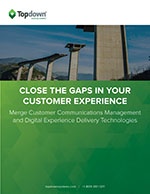Communications
Everything you need to know about customer communications and customer experience!

Customer Experience | Customer Communications
By:
John Zimmerer
June 9th, 2016
The title of Micah Solomon’s recent Forbes article caught my eye: “Stupid Touchpoints Are Worse Than No Touchpoints in Customer Service and Customer Experience.” It proved to be an entertaining and worthwhile read, reminding those of us in customer experience (CX) and customer communications management (CCM) to think very hard about the reasons and ways we touch customers before we start touching them inappropriately (i.e., everywhere, all the time, and turning them off in the process).

Customer Experience | Customer Communications
By:
John Zimmerer
May 25th, 2016
In Three Ways to Use CCM Metrics, Analytics to Improve Customer Experience, one of the three methods I mentioned was multichannel contextualization:


Customer Experience | Customer Communications
By:
John Zimmerer
May 11th, 2016
Unless you’re a brand-spanking-new startup, your organization almost certainly has legacy software. By “legacy,” we mean previously acquired and now outdated – any software that was purchased when business requirements and market dynamics were different than they are today.

Customer Experience | Customer Communications
By:
John Zimmerer
May 6th, 2016
All companies have two topline objectives, regardless of industry, size or business model: revenue growth and profitability. So the metrics that companies gather for any business function, including customer communications management (CCM), usually speak to one or both of these. Profitability usually gets translated to CCM in terms of operational efficiency. The goal is simply to spend less generating, distributing and tracking communications. Since customer service call centers are usually the most costly way to deliver customer service, there’s a lot of sensitivity around call center volume, resolution rates, cost per touch, etc. So companies work to deflect the need for customers to use the call center through methods such as customer self service portals and improved customer communications.

Customer Experience | Customer Communications
By:
John Zimmerer
April 26th, 2016
Cloud-based software and software-as-a-service (SaaS) solutions appeal to many enterprises. Most companies are either looking for software they can access through a web browser and/or they want to subscribe to or “rent” their software for a monthly fee. How an organization pays for its software is often a function of their CFO’s preference — for example, to capitalize the purchase of software for EBITDA reasons, or treat it as a monthly operating expense for cash flow reasons. Why an organization uses and where it manages its software, however, come down to line of business and IT requirements.

Customer Experience | Customer Communications
By:
John Zimmerer
November 21st, 2015
What Is ETL? ETL stands for Extract, Transform and Load. It refers to a database usage process that pulls data from one or more data sources; transforms the data, or changes it to a format or structure that is accessible for queries and suitable for analysis; and loads it into the final target database, data warehouse or application. Typically, since data extraction can take some time – particularly when it’s consolidating large amounts of information from different sources – the transformation and loading steps may begin before extraction is complete. This means that while data is being pulled, a transformation process can execute, preparing the data for loading; data loading may then begin without waiting for the completion of the other phases.